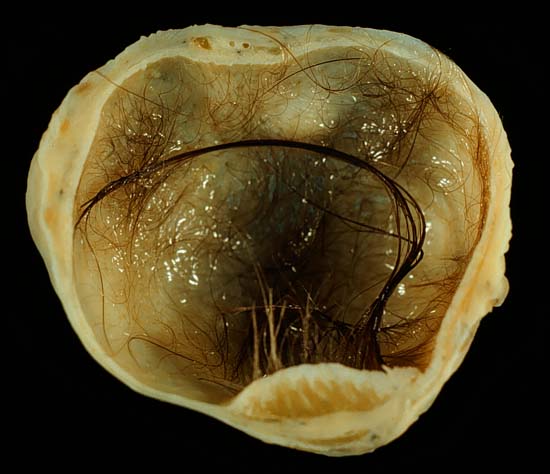Tumors are abnormal masses of tissue that usually form when cells go rogue, be that due to uncontrollable cell growth or division, or refusing to die when they should. We have rounded up some of the most bizarre cases where tumors didn’t just misbehave… but went completely off-script.
A patient’s tumor was accidentally transplanted into a surgeon

Yikes!
Image credit: Akarawut/Shutterstock.com
In this case from 1996, a 32-year-old man had emergency surgery for a malignant fibrous histiocytoma, which is a type of sarcoma (a type of cancer that starts in the soft tissue). It was located in his abdomen, and he unfortunately died after the surgery from postoperative complications.
While the surgeon was placing a drain in the patient’s body, he injured the palm of his left hand. This injury was immediately disinfected and dressed.
Afterwards, this area had a hard, tumor-like swelling measuring 3 centimeters (1.2 inches) in diameter, which was confined to a limited area. Five months later, he visited a hand specialist, and after an extensive examination, the specialist confirmed there was no immune deficiency, and the tumor that was found was removed.
It was revealed that this tumor was a malignant fibrous histiocytoma – the same type the previous patient had. The pathologist who investigated both the surgeon’s and patient’s tumors questioned whether the two were identical, as morphologically they looked the same.
When the research team looked into the genetic components of both tumors, it appeared the sarcoma had been accidentally transplanted from a patient to the surgeon.
Typically, when tissue is transplanted from one person to another, the immune system kicks in and rejects it. In this case, there was an intense inflammatory response in the tissue surrounding the tumor – but it may have been an ineffective response, as the tumor mass increased in size, suggesting it escaped destruction by the immune system.
A tapeworm gave a person cancer

Adult dwarf tapeworm.
Imagine getting worms and thinking that was the worst part, but then that tapeworm gave you cancer. That unfortunate thing happened to a HIV-positive Colombian man in one of the rarest medical cases.
This case occurred in 2013. The man initially presented with a cough, fatigue, fever, and weight loss that had lasted several months. He had been diagnosed with HIV in 2006 but was nonadherent to therapy.
When the medical team examined his stool sample, it was revealed that he had Hymenolepis nana eggs and Blastocystis hominis cysts. H. nana, also known as the dwarf tapeworm, is currently the most common tapeworm to infect humans – in endemic areas, there can be up to 26 percent prevalence. Typically, people don’t show symptoms, and the worm can quietly complete its entire life cycle in the small intestine.
The patient’s white blood cell count was very low, and virus particles were present in his blood samples. A computed tomographic (CT) scan revealed nodules in his lungs, adrenal glands, and liver. He was then given albendazole (anti-worm medication) and antiretroviral medication for his HIV.
As his condition worsened, more samples were taken and sent to the Centers for Disease Control and Prevention (CDC). They found the most unusual features in the samples. The biopsies showed what looked like cancer, but the cells were tiny – some smaller than a human red blood cell – which was very unusual.
When scientists dug deeper, they discovered that the tumor DNA matched H. nana with 99 percent sequence identity. Even more bizarrely, some of the worm’s tumor DNA was mutated in ways that mirrored human cancer mutations.
“Three of the identified genes that were ‘broken,’ or mutated, have already been implicated in other forms of human cancer,” study author Dr Peter Olson told IFLScience in 2015. “If they mutate in humans, they can lead to a cell becoming cancerous. That’s never really been shown, that sort of commonality between becoming malignant in a human cell line and an invertebrate cell line.”
Tragically, this diagnosis came too late. Just 72 hours after this discovery, the patient passed away.
This was the first documented case of a parasitic worm infecting a human, developing cancer inside itself, and then effectively transmitting that cancer to its host.
In people with healthy immune systems, parasitic cells like this would normally be detected and cleared. But in this case, the man’s HIV-compromised immune system allowed the tapeworm cells to grow out of control and develop cancer-like mutations.
“The report is not that there is a new health risk that people should be worried about,” said Olson. “The importance is awareness. It’s a conundrum for clinicians when they look at these tumors. There’s nothing anatomically to suggest they could be from a worm. But now this report is published, doctors should hopefully look out for this possibility.”
Teeth and other bizarre things found in tumors

A mature cystic teratoma with hair inside.
Ah, good old tetratomas, the tumor that is whispered about in shock and horror by students. The “I heard they removed a tumor from someone’s ovaries and it had teeth!” kind.
These bizarre biological concoctions are a very rare type of tumor that can contain multiple types of tissues – like bone, hair, muscle, and teeth. This tumor can be cancerous, but they are mostly benign. Typically, they grow very rapidly, but the benign ones do not spread to other parts of the body.
They have been found in ancient human remains. For example, there was an ancient Egyptian woman who died over 3,300 years ago. The tumor was discovered in her pelvis, and yes it did contain teeth.
More recently, a 16-year-old girl in Japan underwent an appendectomy, when surgeons discovered a tumor in her ovary, although she had not had any symptoms beforehand. When the surgeons investigated the tumor, they found a small mass of highly organized neural tissue, which resembled part of the brain.
A brain tumor that helped diagnose a brain tumor

What a headache!
Image credit: Antonio Guillem/Shutterstock.com
A woman in her early 40s was at home when a voice started to talk to her, however, there was no one else in the room with her.
“Please don’t be afraid. I know it must be shocking for you to hear me speaking to you like this, but this is the easiest way I could think of,” the voice told her, according to the 1997 report. “My friend and I used to work at the Children’s Hospital, Great Ormond Street, and we would like to help you.”
She went to seek psychiatric help and was given medications and counseling for a diagnosed hallucinatory psychosis. For a little bit, the voices went away, until she went on holiday abroad and they returned. This time, they told her to return to England because there was something wrong with her.
The voices gave her an address to visit. When she arrived, it turned out to be the CT department in a large London hospital.
They also told her that she had a brain tumor, and she really should hurry up and ask for a scan. Distressed, she saw a psychiatrist, who (hoping to reassure her) ordered the scan.
The results astounded the medical professionals: she actually did have a tumor. She underwent surgery to have it removed, and when she woke up she heard:
“We are pleased to have helped you. Goodbye.”
The voices never returned.
Professionals have tried to explain this case. Some suggested she might have known she had a tumor and concocted the voices to get free treatment from the NHS. However, this is unlikely, as she already qualified for free healthcare. Others speculated she may have had a strange sensation in her brain that somehow triggered the hallucination.
The headspin hole

This will make your head spin.
Image credit: Volodymyr_Shtun/Shutterstock.com
Imagine your love of dancing ended up causing a tumor. For breakdancers, this can certainly happen. It’s called the “headspin hole”, and it’s the result of repetitive headspins that lead to a fibrous mass on the scalp, along with hair loss and tenderness.
One case report involved a man in his early 30s who, after five years of intense spinning, developed a scalp protuberance (essentially, a lump or swelling).
A magnetic resonance imaging (MRI) scan revealed a tumor-like mass, and he successfully underwent surgery to remove it. The surgery relieved the symptoms and improved the appearance of the affected area. Further analysis revealed the tumor was not malignant.
Tumors are often bad news; however, it is even more shocking when they turn out to be the bizarre, tooth-growing, hallucination-inducing anomalies that we have seen here. These cases remind us that biology isn’t just weird, it’s downright unhinged when it wants to be.
Source Link: Five Times A Tumor Behaved Downright Weird